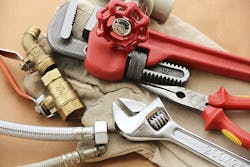CHICAGO — Finally, it seems that there will be some positive economic traction in 2015, and the plumbing industry is slowly, but surely benefiting by this.
According to Kevin Tindall, president of the PHCC – National Association, the association is hoping that conditions will continue to gradually improve, as they did in 2014. Tindall is also president of Tindall & Ranson Plumbing, Heating & Air Conditioning, Princeton, New Jersey.
“Our members — in both service and repair and new construction — report they are very busy these days, and they expect more work to come in the next few months,” said Tindall. “The latest reports about job growth and rising wages, along with lower fuel prices, should have a positive effect on the construction industry, as customers may have more money to spend on projects. Although an expected rise in short-term interest rates could slow the pace of growth in the coming months, we still expect a good year.”
Tindall did point out that even with economic growth there will be challenges, one of them being finding skilled men and women to do the work.
Jack Tester, CEO of Nexstar Network, agrees that the labor market remains a challenge.
“Contractors who are actively and creatively recruiting to hire and develop top management and field talent are the ones really thriving,” said Tester. “The labor market remains tough and you have to be an employer of choice, offering top-pay, full benefits and a positive work environment. Being able to attract and retain top talent continues to separate successful contractors from companies who are struggling.”
Tester pointed out that residential plumbing service has demonstrated a strong business cycle since 2010 all the way through 2014 as the economy recovers.
“We see business improving, and Nexstar’s member contractors are expanding to capture this growing consumer demand,” said Tester. “Barring something dramatic, 2015 should also be a good year for the residential service and replacement business.”
According to Carl Pinto, director of marketing at Bradford White Corp., the repair and replacement market is still doing well, and there will be continued growth in the multi-family segment of new construction.
“All projections and feedback from the field suggest that we will be on par or slightly better than last year in the repair and replacements market,” said Pinto.
2014 Book of Giants — This is Going to be Good
The political forecast is generally no with an occasional yes
During 2014, A.O. Smith saw improvement in housing starts, and the company expects that trend to continue into 2015.
“We’ve seen a quicker recovery from the economic downturn than anticipated, and high efficiency products, like tankless and heat pump, have bounced back strong,” said David Chisolm, vice president of marketing at A. O. Smith. “We see sustained growth in the commercial sector as well. Certain vertical segments are stronger than others, but collectively this segment is showing signs of healthy recovery.”
According to the article “2015 Forecast With The Experts,” Chris Peel, senior vice president and COO of Rheem, noted that the company is cautiously optimistic about the economy as we head into 2015. “Like most businesses, we look at the typical economic indicators such as GDP growth, interest rates, unemployment figures, the various consumer confidence indices and certain housing data,” said Peel. “Together, those economic indicators present a relatively optimistic view of 2015; however, we are keeping our eye on relatively unstable global economic indicators as well.”
Assess emerging markets
With a positive economic outlook this year, there are certain steps contractors can take to grow their businesses.
“PHCC advises contractors to focus all the time on putting the right processes in place and continually assess trends and opportunities, so that they are prepared for both good and bad times,” explained Tindall. “The most successful companies have done that. They also have embraced new technologies and procedures to make their companies more efficient.”
What are the new technologies and niches contractors can tap into to grow their businesses? For starters there is the water conservation and energy efficiency arena.
“There are definitely opportunities to grow your business by becoming recognized as an expert in water conservation and energy efficiency,” said Tindall. “My company, for instance, offers residential energy and water audits, which has differentiated us from other companies. We market that service, and also make sure our customers know about New Jersey’s Clean Energy Grants and interest-free loan program.”
According to FMI’s 3rd Quarter 2014 Construction Outlook Report, water is a commodity in limited supply, just like oil, gas and gold, only more precious. FMI also noted that only 1 percent of available water is potential drinking water, and even though clean drinking water is critical health issue, we also must have sufficient water for manufacturing, farming and recreation needs.
Based on FMI’s report, it’s easy to see why water conservation is an area in which plumbing contactors should grow their businesses. It is important for contractors to educate employees about sustainability, so they can discuss water conservation products and systems with their customers.
“They want to know what types of savings they will see and how long it will take to recoup their investment before they move forward,” said Tindall.
To stay on the cutting edge of the industry and ride the wave of the economy, whether good or bad, Tindall’s advice is to always assess emerging markets, such as aging in place and other opportunities that could be a good fit for a company, then consider what resources are available to help you branch out into a specific area.
New regulations
According to Tindall, the new water heater standards as part of the National Appliance Energy Conservation Act (NAECA), are definitely a game changer for the plumbing industry.
“We have been encouraging our members to prepare for the new regulations via seminars, special publications, webinars and updates on our website,” said Tindall. “It’s really too early to know the full impact this will have on contracting businesses. The manufacturers are the ones most affected at this point. Right now, contractors need to be analyzing what changes may need to occur in their businesses related to storage, transportation, inventory, etc. Fortunately, contractors can still buy and install existing products after the changeover date.”
Tester told CONTRACTOR that once the water heater standards are in place, the only real change he sees is the average ticket of water heater replacements, and margin dollars should increase.
“For contractors who are proactive, this changing regulation could actually be an early replacement opportunity to share with customers, much like the recent efficiency change in air conditioning,” explained Tester. “For example, contactors may tell customers, ‘If you are thinking of replacing your water heater in the next two years, consider doing so now because you have more choice today than after April…’ This type of message should resonate with homeowners, shoring up business before the change takes place.”
Pinto has no doubt that NAECA will have an impact as homebuilders along with their architects will have to take into account some of the key product differences, such as size and/or technology, when specifying water heating equipment.
“Plumbing contractors may find themselves installing a wider variety of water heaters and possibly some in re-designed or non-traditional spaces as homebuilders design and spec based on the new NAECA compliant products,” said Pinto.
According to Chisolm, contractors who do new construction work should start discussing these changes with their clients now — that way everyone is thinking about how future projects and planning budgets are designed and funded to accommodate the 2015 product choices.
“There will be a transition period, but ultimately, it is much easier and cost effective to design for different equipment in new construction simply because one is starting with a blank canvas,” said Chisolm.
In the replacement market, there are more significant accommodations to consider, according to Chisolm, and in many cases, new product will replace the previous product with very little adjustments. Yet, there will be some situations where new technology will need to be considered.
“In general, contractors should become aware of the new products and new technologies so they can accurately recommend the proper product to their customer base,” said Chisolm.
Pinto summed up the new regulations perfectly. “Clearly, when it comes to our facet of the industry, all eyes will be on the new water heater energy factor requirements that go into effect on April 16, 2015,” said Pinto. “Manufacturers will have to be prepared to help their customers through this.”



